The regulation of veratridine-stimulated electrogenic ion transport in mouse colon by neuropeptide Y (NPY), Y1 and Y2 receptors
- PMID: 16100526
- PMCID: PMC1751203
- DOI: 10.1038/sj.bjp.0706368
The regulation of veratridine-stimulated electrogenic ion transport in mouse colon by neuropeptide Y (NPY), Y1 and Y2 receptors
Abstract
1 Neuropeptide Y (NPY) is a prominent enteric neuropeptide with prolonged antisecretory effects in mammalian intestine. Veratridine depolarises neurons consequently causing epithelial anion secretion across mouse colon mucosa. Our aim was to characterise functionally, veratridine-stimulated mucosal responses and to determine the roles for NPY, Y(1), and Y(2) receptors in modulating these neurogenic effects. 2 Colon mucosae (with intact submucous innervation) from wild-type mice (+/+) and knockouts lacking either NPY (NPY-/-), Y(1)-/- or Y(2)-/- were placed in Ussing chambers and voltage clamped at 0 mV. Veratridine-stimulated short-circuit current (I(sc)) responses in +/+, Y(1) or Y(2) antagonist pretreated +/+ colon, Y(1)-/- and NPY-/- colon were insensitive to cholinergic blockade by atropine (At; 1 microM) and hexamethonium (Hex; 10 microM). Tetrodotoxin (TTX, 100 nM) abolished veratridine responses, but had no effect upon carbachol (CCh) or vasoactive intestinal polypeptide (VIP)-induced secretory responses. 3 To establish the functional roles for Y(1) and Y(2) receptors, +/+ tissues were pretreated with either the Y(1) or Y(2) receptor antagonist (BIBO3304 (300 nM) or BIIE0246 (1 microM), respectively) and veratridine responses were compared with those from Y(1)-/- or Y(2)-/- colon. Neither BIBO3304 nor Y(1)-/- altered veratridine-induced secretion, but Y(1) agonist responses were abolished in both preparations. In contrast, the Y(2) antagonist BIIE0246 significantly amplified veratridine responses in +/+ mucosa. Unexpectedly, NPY-/- colon exhibited significantly attenuated veratridine responses (between 1 and 5 min). 4 We demonstrate that electrogenic veratridine responses in mouse colon are noncholinergic and that NPY can act directly upon epithelia, a Y(1) receptor effect. The enhanced veratridine response observed in +/+ tissue following BIIE0246, indicates that Y(2) receptors are located on submucosal neurons and that their activation by NPY will inhibit enteric noncholinergic secretory neurotransmission. 5 We also demonstrate Y(1) and Y(2) receptor-mediated antisecretory tone in +/+ colon and show selective loss of each in Y(1) and Y(2) null colon respectively. In NPY-/- tissue, only Y(1)-mediated tone was present, this presumably being mediated by endogenous endocrine peptide YY. Y(2) tone was absent from NPY-/- (and Y(2)-/-) colon and we conclude that NPY activation of neuronal Y(2) receptors attenuates secretory neurotransmission thereby providing an absorptive electrolyte tone in isolated colon.
Figures
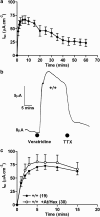
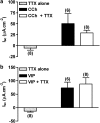


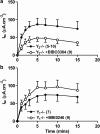
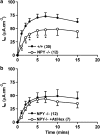
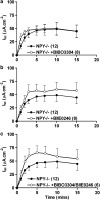

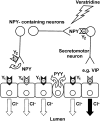
Similar articles
-
Functional consequences of neuropeptide Y Y 2 receptor knockout and Y2 antagonism in mouse and human colonic tissues.Br J Pharmacol. 2003 Jun;139(4):863-71. doi: 10.1038/sj.bjp.0705298. Br J Pharmacol. 2003. PMID: 12813010 Free PMC article.
-
Neuropeptide Y, Y1, Y2 and Y4 receptors mediate Y agonist responses in isolated human colon mucosa.Br J Pharmacol. 2002 Mar;135(6):1505-12. doi: 10.1038/sj.bjp.0704604. Br J Pharmacol. 2002. PMID: 11906964 Free PMC article.
-
Endogenous peptide YY and neuropeptide Y inhibit colonic ion transport, contractility and transit differentially via Y₁ and Y₂ receptors.Br J Pharmacol. 2011 Sep;164(2b):471-84. doi: 10.1111/j.1476-5381.2011.01401.x. Br J Pharmacol. 2011. PMID: 21457230 Free PMC article.
-
Neuropeptide Y receptors; antisecretory control of intestinal epithelial function.Auton Neurosci. 2007 Apr 30;133(1):76-85. doi: 10.1016/j.autneu.2006.10.005. Epub 2006 Nov 30. Auton Neurosci. 2007. PMID: 17140858 Review.
-
Neuropeptide Y Y1 receptor mechanisms in sympathetic vascular control.Acta Physiol Scand Suppl. 1997;636:1-55. Acta Physiol Scand Suppl. 1997. PMID: 9179320 Review.
Cited by
-
Myosin light chain kinase inhibition: correction of increased intestinal epithelial permeability in vitro.Pharm Res. 2008 Jun;25(6):1377-86. doi: 10.1007/s11095-007-9527-6. Pharm Res. 2008. PMID: 18163202
-
Gastrointestinal neuroendocrine peptides/amines in inflammatory bowel disease.World J Gastroenterol. 2017 Jul 28;23(28):5068-5085. doi: 10.3748/wjg.v23.i28.5068. World J Gastroenterol. 2017. PMID: 28811704 Free PMC article. Review.
-
Peptide Tyrosine Tyrosine 3-36 Reduces Meal Size and Activates the Enteric Neurons in Male Sprague-Dawley Rats.Dig Dis Sci. 2017 Dec;62(12):3350-3358. doi: 10.1007/s10620-017-4788-3. Epub 2017 Oct 13. Dig Dis Sci. 2017. PMID: 29030744
-
Ileitis alters neuronal and enteroendocrine signalling in guinea pig distal colon.Gut. 2007 Feb;56(2):186-94. doi: 10.1136/gut.2006.102780. Epub 2006 Aug 24. Gut. 2007. PMID: 16931576 Free PMC article.
-
Endogenous PYY and NPY mediate tonic Y1- and Y2-mediated absorption in human and mouse colon.Nutrition. 2008 Sep;24(9):900-6. doi: 10.1016/j.nut.2008.06.015. Epub 2008 Jul 26. Nutrition. 2008. PMID: 18662856 Free PMC article.
References
-
- ALLESCHER H.D., KURJAK M., HUBER A., TRUDRUNG P., SCHUSDZIARRA V. Regulation of VIP release from rat enteric nerve terminals: evidence for a stimulatory effect of NO. Am. J. Physiol. 1996;271:G568–G574. - PubMed
-
- BATTERHAM R.L., COWLEY M.A., SMALL C.J., HERZOG H., COHEN M.A., DAKIN C.L., WREN A.M., BRYNES A.E., LOW M.J., GHATEI M.A., CONE R.D., BLOOM S.R. Gut hormone PYY(3–36) physiologically inhibits food intake. Nature. 2002;418:650–654. - PubMed
-
- BELAI A., BURNSTOCK G. Release of calcitonin gene-related peptide from rat enteric nerves is Ca2+-dependent but is not induced by K+ depolarization. Regul. Pept. 1988;23:227–235. - PubMed
-
- CATTERALL W.A. Neurotoxins that act on voltage-sensitive sodium channels in excitable membranes. Annu. Rev. Pharmacol. Toxicol. 1980;20:15–43. - PubMed
-
- COX H.M., CUTHBERT A.W. Neuropeptide Y antagonises secretagogue evoked chloride transport in rat jejunal epithelium. Pflugers Arch. 1988;413:38–42. - PubMed
Publication types
MeSH terms
Substances
LinkOut - more resources
Full Text Sources
Other Literature Sources
Molecular Biology Databases
Research Materials
Miscellaneous

